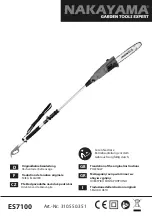
-19-
Do not use:
-
Cracked and misshapen saw blades.
-
Saw blades made of high speed steel (HSS saw
blades).
-
Blunt saw blades as they impose an excessive
load on the motor.
-
Saw blades with a base body with a thickness
greater than, or a cutting width (setting) less than,
the thickness of the riving knife / splitter.
-
Saw blades which are not suitable for the saw
blade's idling speed.
Instructions on the use of personal protective
equipment:
-
Always wear ear protectors during work.
-
Always where a dust mark during work.
Instructions on operation:
-
Do not reach with your hands into the sawing area
and do not touch the saw blade. With your other
hand, support the supplementary handle or the
motor casing.
-
Do not reach under the workpiece.
-
Adapt the cutting depth to the workpiece thickness.
-
Never support the workpiece in your hand or over
your leg. Secure the workpiece against a sturdy
support.
-
Only hold the device by its isolated handle
surfaces when carrying out work during which the
cutting tool could hit hidden power cables or its
own connection cable.
-
Always use a limit stop or a straight edge guide for
longitudinal cutting.
-
Always use correctly sized saw blades with
matching receiving bore (e.g. star-shaped or
round).
-
Never use damaged or incorrect saw blade
washers or screws.
-
Hold the saw with both hands and bring your arms
into a position where you are able to resist the
backlash forces. Always keep to the side of the
saw blade. Never bring the saw blade in line with
your body.
-
If the saw blade gets jammed or sawing is
interrupted for some other reason, release the
on/off switch and keep the saw steady in the
material, until the saw blade has come to a
complete standstill. Never try to remove the saw
from the workpiece or to pull it backwards while the
saw blade is still moving or while a backlash could
occur.
-
If you would like to restart a saw that is stuck in the
workpiece, centre the saw blade in the saw slit and
check whether the saw teeth are stuck in the
workpiece.
-
Support large plates to reduce the risk of backlash
caused by a jammed saw blade.
-
Do not use any blunt or damaged saw blades.
-
Before starting to saw, tighten the cutting depth
and cutting angle adjustments.
-
Be especially careful when making a “plunge cut“
into a concealed area, e.g. into an existing wall.
-
Prior to every use, check whether the lower saw
guard is closing properly. Do not use the saw if the
lower saw guard is not freely movable and does
not close immediately. Never clamp or tie down the
lower saw guard in an open position.
-
Check the function of the spring for the lower saw
guard. Have the device serviced if lower saw guard
and spring do not work properly.
-
Only manually open the lower saw guard for
special cuts, such as “plunge and angle cuts“.
Open the lower saw guard using the retracting
lever and release the lever as soon as the saw
blade has penetrated the workpiece.
-
Do not place the saw on the work bench or on the
floor without the lower saw guard covering the saw
blade.
-
Use the saw blade that matches the riving
knife/splitter
-
Adjust the riving knife / splitter as described in the
operating instructions.
-
Always use the riving knife / splitter except for
“plunge cuts“.
-
For the riving knife / splitter to function, it has to be
located in the saw slit.
-
Never operate the saw with a bent riving knife /
splitter.
-
Examine the workpiece for foreign objects. Never
attempt to cut into nails or other metal objects.































